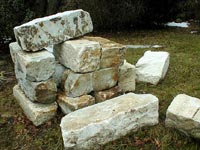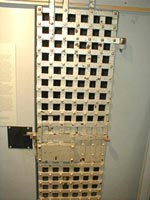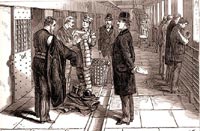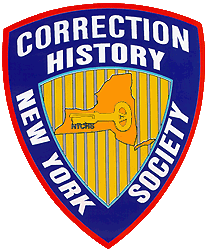|
Ch. 1: The Beginning
In 1825, the state legislature gave the job of building a new, more modern prison to Captain Elam Lynds, a prison warden from upstate . . . Lynds spent months investigating possible locations for the facility including Staten Island, the Bronx and an area called Mt. Pleasant on . . . the Hudson River.
He also visited New Hampshire where a prison was successfully constructed by inmate labor using stone . . . on site. For this reason, Lynds selected Mt. Pleasant, located near a small village in Westchester County with the unlikely name of Sing Sing. It was derived from the Indian words, "Sint Sinks" which translates to "stone upon stone." The legislature appropriated $20,100 for the land and the project soon received the official stamp of approval.
 Marble stones cut by 19th century inmates that were part of walls of Sing Sing prison. (photo by author)
Marble stones cut by 19th century inmates that were part of walls of Sing Sing prison. (photo by author)
|
In May 1825, Lynds and 100 inmates from the depths of Auburn prison were loaded onto a wooden barge and sailed down the Hudson River to Mt. Pleasant. There, under the most stringent conditions imaginable, exposed to the elements, with little food, no buildings or shelter of any kind, construction began on Sing Sing prison . . . destined to become one of the most repressive institutions in America.
Ch. 2: The Profit of Slave Labor
One of the reasons the Mt. Pleasant site was chosen . . . was the availability of stone. The banks of the Hudson River at this location offered an abundant quality of high-grade marble. Quarrying was already a major industry in the Hudson Valley and a leading supplier of stone to New York City, Boston and Albany. Cut stone . . . financed the cost of building the prison. Using these funds, Lynds began work on a blacksmith shop, temporary barracks and a makeshift cooking area.
After months of backbreaking labor, the prisoners were able to complete 60 . . . cells. A cell for Sing Sing was only seven feet long by three feet wide and six feet seven inches high. . . . The design for the facility called for . . .800 such cells, stacked on top of each other, four cells high, in a building that was 476 feet long. But Lynds . . . pushed the inmates to the limits of human endurance and ruled by the whip and the yoke. . . . the main building was completed in 1828 ...
 A typical cell door from the original Sing Sing 1825. (photo by author)
A typical cell door from the original Sing Sing 1825. (photo by author)
|
A common practice used during the 19th century in American prisons was contract labor. This alliance between private contractors and prison officials enabled wardens to contract inmate labor out to private industry for profit. . . . contract supervisors were frequently brutal men who demanded more and more productivity. . . .The inmate workday at Sing Sing was 10 hours, exclusive of meals, and almost every prisoner had to participate in the system.
. . . More than 73% of the prisoners at Sing Sing in 1854 were used under contract labor to produce such items as furniture, carpets, tapestry, shoes, bedding, cigars and cut stone.
By 1890, after a strong lobbying effort by area unions, laws were passed which prohibited prison contract labor. The immediate effect was disastrous. Warden A. A. Bush said "Over a thousand men are now locked in their cells with nothing to do. Idleness in a prison is horrible . . . ."
. . . over the next decade, inmate labor returned to Sing Sing. But a compromise was reached. All items produced would be utilized by the state of New York, not the public.
Ch. 3: Discipline and Control
. . . various methods of repression and discipline evolved inside the prison walls. These methods ranged from the "silent system," devised in the 19th century at New York's Auburn prison, to actual instruments of torture such as steel cages and the lash. In 1864, Sing Sing records show that 613 out of 796 prisoners received some sort of physical punishment. One man was punished twenty-two times . . .
. . . However, it is also important to remember that this type of violence was a reflection of the era as well.
 Admission procedure in 19th century
Sing Sing. A drawing from Frank Leslies
Illustrated Newspaper February 16,
1878. (Courtesy of Ossining Historical
Society)
Admission procedure in 19th century
Sing Sing. A drawing from Frank Leslies
Illustrated Newspaper February 16,
1878. (Courtesy of Ossining Historical
Society)
|
. . . The prisoners ate in silence, worked in silence and existed in a quiet world where penitence was the goal. They walked together in lockstep, in their striped prison uniforms, like robots, one behind another. . . . Inmates were given a Bible to read and were allowed no visitors . . . . Meditation was encouraged. . . . Any violation of the silent system was treated with harsh and immediate punishment. Most wardens believed that to ignore any infraction committed by an inmate was to encourage rebellion. . . .
One method of torture was "the bath," used for decades at Sing Sing to terrify the population and maintain order. An inmate was tied to a chair . . . the water was dropped in a steady stream from a great height and landed on the top of a prisoner's head. Prison records show that 170 men received this punishment in 1852. That same year, 120 men were placed in solitary confinement and five were "bucked." . . . causing the man to hang upside down like a roasted pig. . . .
In the early years at Sing Sing, floggings were common. Since there was no standard code of punishment, the duration of these beatings was left to the whim of the guards. . . .
Since food was scarce and little attention was paid to its quality, inmates were most often in a weakened condition. . . . If a man was sent "up the river," there was a chance he was never coming back alive. . . .
|

 NYCHS is honored to be permitted to post this excerpts presentation of Mark Gado's Stone Upon Stone: Sing Sing Prison appearing on Court TV's Crime Library web site that retains all rights under its copyright. Visit Court TV's Crime Library web site to view the complete 16-chapter article, including more historical images, a useful bibliography and the full long list of New Rochelle Detective Gado's other articles on that site. Thanks also to the Ossining Historical Society for use of images from its archives.
NYCHS is honored to be permitted to post this excerpts presentation of Mark Gado's Stone Upon Stone: Sing Sing Prison appearing on Court TV's Crime Library web site that retains all rights under its copyright. Visit Court TV's Crime Library web site to view the complete 16-chapter article, including more historical images, a useful bibliography and the full long list of New Rochelle Detective Gado's other articles on that site. Thanks also to the Ossining Historical Society for use of images from its archives. Marble stones cut by 19th century inmates that were part of walls of Sing Sing prison. (photo by author)
Marble stones cut by 19th century inmates that were part of walls of Sing Sing prison. (photo by author)
 A typical cell door from the original Sing Sing 1825. (photo by author)
A typical cell door from the original Sing Sing 1825. (photo by author)
 Admission procedure in 19th century
Sing Sing. A drawing from Frank Leslies
Illustrated Newspaper February 16,
1878. (Courtesy of Ossining Historical
Society)
Admission procedure in 19th century
Sing Sing. A drawing from Frank Leslies
Illustrated Newspaper February 16,
1878. (Courtesy of Ossining Historical
Society)